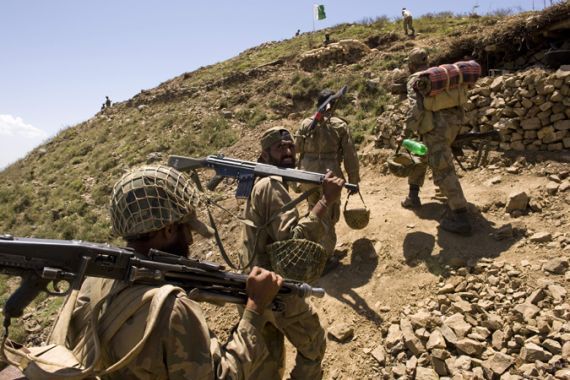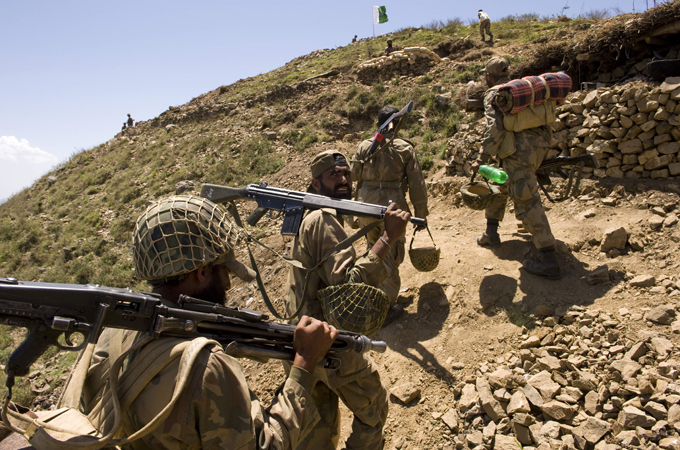Cables show US special operations in Pakistan
Leaked US diplomatic messages show Pakistani military requested more drone strikes and help from US special forces.

 |
| Pakistani troops fighting the Taliban in the northwest got assistance from embedded US Special Forces [GALLO/GETTY] |
Pakistan’s government called for the US to step up drone strikes, and asked for US special forces troops to be embedded at Pakistani military bases, leaked cables published by a Pakistani newspaper have revealed.
The classified US diplomatic cables were published on Saturday by Dawn, Pakistan’s largest English-language newspaper, detailing close relationships between American and Pakistani militaries and intelligence services.
Keep reading
list of 4 itemsEurope pledges to boost aid to Sudan on unwelcome war anniversary
Birth, death, escape: Three women’s struggle through Sudan’s war
Does Israel twist humanitarian law to justify Gaza carnage?
Dawn reported that it had signed a deal with Julian Assange, the leader of the online whistleblowing organisation WikiLeaks, to obtain exclusive access to more than 4,700 US cables dealing with Pakistan.
It began publishing those cables and its coverage of them on Saturday and said its reporting would continue “in the following days.”
The first batch of cables shows that Pakistani officials, including those as high-ranking as Army Chief of Staff Ashfaq Parvez Kayani, explicitly asked US representatives to increase drone activity in Pakistan – the kind of request no Pakistani politician or government official would be comfortable making in public.
In a meeting on January 22, 2008, Kayani asked Admiral William J. Fallon, the commander of the US Central Command, to provide “continuous Predator [drone] coverage of the conflict area” in South Waziristan, a district in the semi-autonomous Federally Administered Tribal Areas (FATA) on the northwest border with Afghanistan, where Pakistan has battled elements of the Taliban.
Fallon said he could not make that happen, but offered to put US Marines on the ground in Pakistan to coordinate air strikes for Pakistani troops. Kayani said that “would not be politically acceptable.”
Less than two months later, Kayani met with Admiral Mike Mullen, the chairman of the Joint Chiefs of Staff, and asked for help approving a “third Restricted Operating Zone for US aircraft over the FATA,” suggesting that the United States had already secured two zones for drones to operate, but that Pakistan had set conditions on how far the planes could roam.
In September 2009, a high-ranking FATA Secretariat officer told a US diplomat at the nearby Peshawar consulate that the US could help an upcoming Pakistani military operation in South Waziristan with “continued [drone] strikes.”
The FATA bureaucrat even offered a specific strategy.
“He explained that after a strike, the terrorists seal off the area to collect the bodies; in the first 10-24 hours after an attack, the only people in the area are terrorists,” the Peshawar consulate officer, Candace Putnam, wrote.
“You should hit them again – there are no innocents there at that time,'” Putnam quoted the man as saying.
“The official also drew a diagram essentially laying out the rationale for signature strikes that eliminated terrorist training camps and urged that the US do more of these,” she wrote.
Pakistani air force officials recently admitted during a closed-door parliamentary session – called to discuss the US raid that killed Osama bin Laden – that the US flies drones out of Shamsi airbase in the Balochistan province, according to news reports. The officials said the drones flown from Shamsi are for surveillance, and are not armed.
American Special Operations activity in Pakistan has been reported for years but never confirmed by officials in either country. Three US soldiers, who died in a February 2010 Taliban suicide bombing in northwest Pakistan, were among at least 60 to 100 Special Operations troops tasked with training the Frontier Corps in counterinsurgency techniques, the New York Times reported.
Jeremy Scahill, writing for the Nation magazine in December 2009, reported that the US Joint Special Operations Command (JSOC) and private contractors from Xe Services, formerly known as Blackwater, were operating a small and “covert” base out of the southern Pakistani port city of Karachi.
There, Scahill wrote, they planned targeted assassinations and captures of Taliban and al-Qaeda fighters and helped operate a military drone campaign that ran parallel and in secret to that operated by the Central Intelligence Agency.
The United States and Pakistan had agreed as early as 2006 to allow the Joint Special Operations Command to enter Pakistan, he wrote.
The cables released by Dawn confirmed some of these reports, though they did not mention the more explosive accounts about Blackwater and JSOC.
They detailed close, on-the-ground military and intelligence coordination between the United States and Pakistan that had begun by May 2009, when US Ambassador Anne Patterson wrote to State Department headquarters in Washington DC about “Intelligence Fusion” cells the United States had established in Pakistan.
The cells consisted of US Special Forces – Green Berets – embedded with Pakistani Special Security Group (SSG) and Frontier Corps troops, but the US soldiers had not yet been given permission to accompany the Pakistani units on deployments, Patterson wrote.
A night mission with the 3rd Commando Group of the SSG had been planned for April 2009 to attack the Taliban-held city of Daggar, but the Pakistani military cancelled the US involvement at the last moment, saying its forces did not need assistance.
A previously published October 2009 cable described how US troops had been deployed in South and North Waziristan with the Pakistani army’s 11th Corps, after previously joining Pakistani troops in Bajaur. It was unclear whether any of these deployments involved fighting, or just intelligence gathering and training.